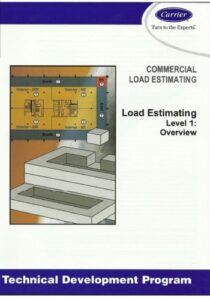Carrier TDP 300 COMMERCIAL LOAD Estimating Level 1 Overview
Carrier TDP 300 COMMERCIAL LOAD Estimating Level 1 Overview
This Technical Development Program Carrier TDP 300 COMMERCIAL LOAD Estimating presents an overview of the uses and characteristics of cooling and heating load estimates, along with the basic types and methods of load estimating used in HVAC system design. The fundamentals of heat transfer methods also theory are explained as foundational material upon which all load estimating is based.
Basic sensible heat transfer by conduction through building materials and solar radiant energy make up the bulk of external loads on a building. Even though computer software load estimating programs perform multitudes of calculations quickly and accurately, the designer needs to have an understanding of the equations and methodologies involved. This TDP shows the designer how to perform a manual U-factor calculation by using material property references also simple mathematics.
You can also Read Carrier TDP 201 Psychrometrics Level 1 Introduction
Carrier TDP 300 COMMERCIAL LOAD Estimating Level 1 Overview
Estimating are needed throughout the HVAC system design process. Typical designs for commercial buildings, such as shown in Figure 1, are developed over time, so building data is often sketchy at first and becomes more detailed as the project progresses. Before proceeding with any load estimate calculations, the building air-conditioned volume must first be defined. That volume, or envelope, could be a space (or room), a floor, or the entire building. Having defined the envelope, the following information will be needed to determine the load estimate:
External dimensions
Glass area
Net wall area
Net ceiling and floor areas
Transmission coefficients (U-factors)
Structural weights and colors
Occupancy
Internal loads
The last part of this TDP introduces the concept of load components. Within the three major categories of external space loads, internal space loads, and system loads are individual load components that permit a load estimate to be prepared piece by piece. This applies to both manual and software-based load estimating methods.

Comments are closed.